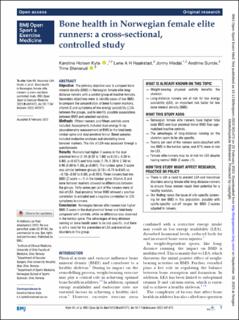| dc.contributor.author | Kyte, Karoline Holsen | |
| dc.contributor.author | Haakstad, Lene Annette Hagen | |
| dc.contributor.author | Hisdal, Jonny | |
| dc.contributor.author | Sunde, Andrine | |
| dc.contributor.author | Stensrud, Trine | |
| dc.date.accessioned | 2023-10-12T12:53:08Z | |
| dc.date.available | 2023-10-12T12:53:08Z | |
| dc.date.created | 2023-03-16T14:17:15Z | |
| dc.date.issued | 2023 | |
| dc.identifier.citation | BMJ Open Sport & Exercise Medicine. 2023, 9(1), Artikkel e001472. | en_US |
| dc.identifier.issn | 2055-7647 | |
| dc.identifier.uri | https://hdl.handle.net/11250/3096152 | |
| dc.description | This is an open access article distributed in accordance with the Creative Commons Attribution Non Commercial (CC BY-NC 4.0) license, which permits others to distribute, remix, adapt, build upon this work non-commercially, and license their derivative works on different terms, provided the original work is properly cited, appropriate credit is given, any changes made indicated, and the use is non-commercial. | en_US |
| dc.description.abstract | Objective: The primary objective was to compare bone mineral density (BMD) in Norwegian female elite long-distance runners with a control group of inactive females. Secondary objectives were to identify cases of low BMD, to compare the concentration of bone turnover markers, vitamin D and symptoms of low energy availability (LEA) between the groups, and to identify possible associations between BMD and selected variables.
Methods: Fifteen runners and fifteen controls were included. Assessments included dual-energy X-ray absorptiometry measurement of BMD in the total body, lumbar spine and dual proximal femur. Blood samples included endocrine analyses and circulating bone turnover markers. The risk of LEA was assessed through a questionnaire.
Results: Runners had higher Z-scores in the dual proximal femur (1.30 (0.20 to 1.80) vs 0.20 (−0.20 to 0.80), p<0.021) and total body (1.70 (1.20 to 2.30) vs 0.90 (0.80 to 1.00), p<0.001). The lumbar spine Z-score was similar between groups (0.10 (−0.70 to 0.60) vs −0.10(−0.50 to 0.50), p=0.983). Three runners had low BMD (Z-score <−1) in the lumbar spine. Vitamin D and bone turnover markers showed no differences between the groups. Forty-seven per cent of the runners were at risk of LEA. Dual proximal femur BMD showed a positive correlation to estradiol and a negative correlation to LEA symptoms in runners.
Conclusion: Norwegian female elite runners had higher BMD Z-score in the dual proximal femur and total body compared with controls, while no difference was observed in the lumbar spine. The advantages of long-distance running on bone health seem to be site specific, and there is still a need for the prevention of LEA and menstrual disorders in this group. | en_US |
| dc.language.iso | eng | en_US |
| dc.subject | athlete | en_US |
| dc.subject | bone density | en_US |
| dc.subject | bone mineral density | en_US |
| dc.subject | endocrine status | en_US |
| dc.subject | female athlete triad | en_US |
| dc.subject | running | en_US |
| dc.title | Bone health in Norwegian female elite runners: A cross-sectional, controlled study | en_US |
| dc.type | Peer reviewed | en_US |
| dc.type | Journal article | en_US |
| dc.description.version | publishedVersion | en_US |
| dc.rights.holder | © Author(s) (or their employer(s)) 2023 | en_US |
| dc.source.pagenumber | 7 | en_US |
| dc.source.volume | 9 | en_US |
| dc.source.journal | BMJ Open Sport & Exercise Medicine | en_US |
| dc.source.issue | 1 | en_US |
| dc.identifier.doi | 10.1136/bmjsem-2022-001472 | |
| dc.identifier.cristin | 2134488 | |
| dc.description.localcode | Institutt for idrettsmedisinske fag / Department of Sports Medicine | en_US |
| dc.source.articlenumber | e001472 | en_US |
| cristin.ispublished | true | |
| cristin.fulltext | original | |
| cristin.qualitycode | 1 | |
